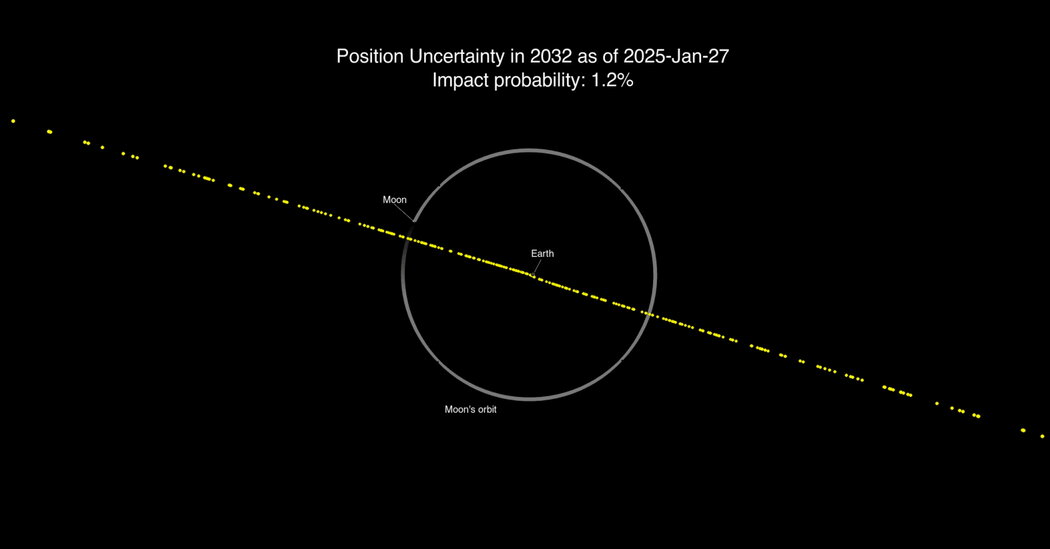
Earth Safe From Asteroid 2024 YR4, NASA Says
- Science
- February 25, 2025
- No Comment
- 182
Astronomers have been carefully watching 2024 YR4, a space rock with a heightened chance of hitting Earth in 2032. But fear not: NASA announced on Monday that it posed a threat no longer — the odds that the asteroid would smash into our planet have dropped to nearly zero.
“I knew this was likely to go away as we collected more data,” said Davide Farnocchia, a navigation engineer at the NASA Jet Propulsion Laboratory in California. “I was sleeping pretty well.”
Days after skywatchers reported their observations of 2024 YR4 on Dec. 27, 2024, scientists calculated that it had more than a 1 percent chance of striking Earth — the only large asteroid known to have an impact probability so big.
As scientists studied more data on the object, the odds of impact continued to rise through January and February, from 1.2 percent to a peak of 3.1 percent on Tuesday last week.
That may sound small, but the probability was higher than any ever recorded by NASA for an object of this size or bigger.
Somewhere between 130 and 300 feet wide, 2024 YR4 is big enough to potentially wipe out a city. Early estimates of the asteroid’s trajectory showed it could possibly slam into or explode in the air over large metropolitan areas, including Mumbai, India, and Lagos, Nigeria.
But the day after the 3.1 percent forecast, the odds that 2024 YR4 would slam into Earth began to drop, to 1.5 percent on Feb. 19, and then to 0.3 percent the day after. On Monday afternoon, NASA shared the “all clear” in a post on X, noting that the probability had further diminished to 0.004 percent, or a one in 25,000 chance.
According to Dr. Farnocchia, that value is already outdated. The newest estimate is even smaller: a one in 59,000 chance.
The probability of impact has shifted in the past two months as astronomers gathered more information about the asteroid from ground-based telescopes. With additional data, the uncertainty of its route through the solar system began to shrink, eventually so much so that planetary defenders decided we were no longer in danger.
“This is normal behavior, what you would expect when you discover an asteroid,” Dr. Farnocchia said. It is “just the scientific process at work,” he added.
While Earth may have evaded destruction by way of asteroid, NASA said there was a slight chance — about 1.7 percent — that 2024 YR4 would crash into our moon, creating yet another crater on its speckled surface.
The agency is continuing to monitor the asteroid from observatories around the world, including with the Lowell Discovery Telescope in Arizona and the Nordic Optical Telescope in the Canary Islands. By the end of April, 2024 YR4 will be hidden from our view until 2028.
“The asteroid is going to do what it’s going to do,” Dr. Farnocchia said. That astronomers found it and measured the odds of a collision so far in advance, he added, “is actually a good sign that we’re doing what we’re supposed to do to deal with the risk of asteroid impacts.”
#Earth #Safe #Asteroid #YR4 #NASA









